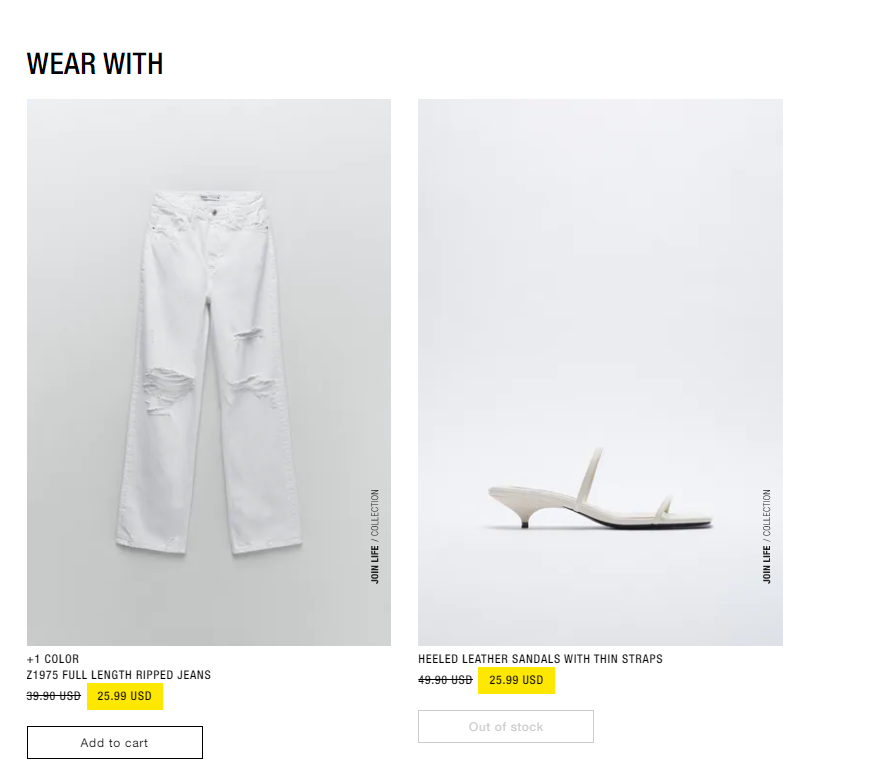
What is Personalisation in e-commerce?
How to start e-commerce Personalisation?
6 working Personalisation examples.
Imagine you want to buy a pair of sneakers on the internet. So, you are opening the browser while entering the request imagining all that time that needs to be spend searching exactly what you want. But then, opening a favourite e-store you immediately see the recommendation on sneakers with colour, material, size and type that you need. “How lucky!” - you will think. But it’s not that simple. Here, personalisation takes place.
What is Personalisation in e-commerce?
Definition
Personalisation in e-commerce is a process of personal experiences and interactions creation for the customers on the e-commerce sites. It can be simply present by dynamically showing content, product recommendations or special offers that are based on the user’s past browsing behaviour, demographics, purchasing history or other personal data. Personalisation includes various software technologies that gather, store, and manage customer data to generate individualised experiences.
It is not about collecting private information, it’s about creating the most comfortable conditions for buyers.
How does personalisation work?
Personalisation on an e-commerce website can be implemented in different ways however the most important thing is that personalisation starts with data collection.
Types of data that can be collected for personalisation:
- Past user’s purchases
- Last behaviour and interactions on the site (recently viewed, products from abandoned carts)
- Behaviour and interactions with marketing advertisements
- Type of the device which customer used to interact with a website
- Demographics
- Geolocation / IP address
- Time
- Weather
- Referral source
- Emails
- Phone numbers
- and thousands more.
And then it can be used to determine what will work best for the specific customer in real-time.
What can be personalised?
- Content
- Product recommendations
- Product displays
- Search results
- Sales Offers
- Advertising
- Onsite Popups
- Currency
- Newsletters
How does Personalisation evaluate?
Personalisation is an increasingly valuable tool for e-commerce that aims to keep your customers engaged and loyal while improving business goal indicators.
Personalisation success can be evaluated with:
- Conversion rate
- Bounce Rate
- Engagement
- Total Time on Site
- Average Page Views
- Average Order Value
- Add-to-Cart Rate
- Cart Abandonment Rate
But you can create your own set of metrics that better meets your personalization efforts.
Why is personalisation important for e-commerce?
Personalisation becomes an integral part of e-commerce. More and more online businesses spend incredible amounts of money to provide their customers with such luxurious support, not for nothing. Numerous researches have already shown why does personalisation must be taken seriously:
- 80% of frequent shoppers only shop with brands that personalise the experience (SmarterHQ).
- 91% of consumers are more likely to shop with brands who recognize, remember, and provide relevant offers and recommendations (Accenture survey).
- 89% of digital businesses are investing in personalised content, including Coca-Cola, Fableticks, Netflix, Sephora, USAA, and Wells Fargo, according to (Forrester research).
- 80% of consumers are more likely to make a purchase when brands offer personalized experiences. (Epsilon research)
- 71% of consumers express some level of frustration when their experience is impersonal and are willing to spend more money when brands deliver targeted recommendations. (Segment research)
- 67% of consumers think it’s important for brands to automatically adjust content based on the current context. When brands don't adjust accordingly, 42% of consumers will "get annoyed" that content isn’t personalized. (Adobe research)
Who needs the personalisation?
Imagine walking in the shop, and suddenly the shop assistant does not speak your language, the currency is not what you have in the pocket, and it seems impossible to find something that you are looking for. This could be a frustrating experience and drive the customer away from this shop, probably to never come back. That is why Personalisation is such a valuable tool, especially for online shopping. Honestly, personalisation should take place in every B2C and B2B segment as it allows giving consumers or businesses what they exactly want. 73% of B2B buyers want personalized experiences, similar to the B2C - like customer experience. Thanks to multiple personalisation forms (read the “6 working personalisation examples” section below) for every product or service the best option can be chosen and developed. However, the problem occurs on the stage “How to start?”.
How to start e-commerce personalisation?
If you haven’t used personalisation yet, it is time to start. As were mentioned before personalisation can be implemented in different ways and within multiple technologies, tools and software. And here you can choose one of 2 ways how to start providing personalisation:
- Providing on your own (choose the personalisation tool, software or technology).
- Choose the agency that provides personalisation.
Providing on your own (choose the personalisation tool)
Some companies and businesses might consider providing personalisation with the help of available tools, using in-house resources. While this could be a good option for small ones on a very tight budget, it usually has the following disadvantages:
- Choosing appropriate tools might be tricky, and will require some knowledge and understanding of the personalisation processes;
- Require trained and experienced personal, otherwise learning process can be lengthy and sometimes expensive;
- There is no guarantee of success if this is a try and error process is being done the first time;
- Can result in actually alienating customers rather than improving the shopping experience.
To start with, determine the following things:
- Understand where and how should the personalisation take place. It mostly depends on where personalisation will bring the best impact on the revenue.
- Determine how you will evaluate a personalisation success. Choose the set of key indicators like Conversion rate, Bounce Rate, Engagement.
- Find several e-commerce personalisation tools to start and train with.
- Assign enough resources and people that will oversee the project.
- Start the personalisation and website segmentation to find the areas that benefit the most.
- Define a long-term strategy basing on personalisation test results.
- Continue to monitor the results and improve the process where needed.
Personalisation tools
Personalisation is a fast-development technology and thanks to Artificial Intelligence (AI) and machine learning it is constantly improving. Such software serves up the right content at the right time for individual site visitors, based on their past behaviour.
How does it work?
AI personalization system reads all the data to identify what it’s about, how long it is, and what format it’s in. Then classifies it with different topics and learns how to orientate within it. With a number of machine learning models and techniques, the system determines what content to recommend to each site visitor. The personalisation system rid you of reading through thousands of search requests and pulling out trends manually. Set your own key points and parameters depending on personalisation goals. However, a tool for personalisation will also need some part of human work like coordinating and feeding the machine with data.
Examples of personalisation tools:
*Choose the system based on your business personalisation goals, carefully examining the abilities of each one.
Choose the agency that professionally provides personalisation
The far easier way to start providing personalisation is to cooperate with a personalisation agency. This might look also like a more expansive option, at least there is probably a higher upfront investment needed. Yet, this way can reduce the time (trial and error process), establish personalisation faster and more professionally, which in the long run will help to improve the customer shopping experience, and as we also know a conversion rate, loyalty and profits.
When technical requirements are clear and the budget well established, then choosing the right partner for the task is the next logical step. Kenner Soft GmbH agency has huge experience in the e-commerce sphere. We provide our customers with professional personalisation set up on the basis of tools like Doofinder AI, Econda which include: shop personalisation, personalised search experience, tracking and analysing user’s behaviour, data protection, unique shopping experience creation etc. In addition, we with great pleasure support you in complex web-shop development. Don’t forget that is very important to find a qualified personalisation provider that can fully manage the project.
6 working personalisation examples
Use product-detail page recommendations
Product-detail page recommendations show customers similar or complementary products to the ones they are already interested in. Such recommendations can not only engage customers to buy more but also to buy more expensive products. For example, ZARAHOME shows similar in style but some of them are higher on price products.


In addition, such reconditions may allow users to reach close categories of products and engage to buy complementary products. For example, on the ZARA website, viewing the shirt, customers also see matching jeans and sandals.


PDP recommendations stimulate shopping and create comfortable shopping conditions allowing to save time on searching or viewing.
Provide a “continue shopping” function
The function to continue from where the user ended is very popular in the movies and serials website, where the user can continue to watch with one click. However, it is also one of the most powerful and useful functions for example to reach customers that leave the site without purchasing. This approach also includes recently viewed products and remembers products or categories the user viewed before and help easily back to them.

Use bestsellers or the most popular products
Bestsellers or most popular products are deliberately attractive because many people have already rated them positively. You can show the products that were purchased the most in the last 24 hours and get a nearly 50% click-through rate or enhance conversion rate from such pages. Sephora

You can go further and show the most reviewed products by location. For example, users from France can search other clothes for the summer unlike users from United Kindom.
Personalised pop-ups and ads
On-site interstitials are a good approach to personalise shopping. However, pop-ups and advertisements should be intuitive and relevant. You can run pop-ups based on the user’s in-session behaviour both historical and real-time ( search behaviour, cart value, etc.). Or run the ads with special offers only for new users.
.jpeg)
Retargeting
Based on the past user’s behaviour, it is simple to make retargeting. In such a case you will remind about the viewed product or prevent the purchase in a competitor. To save costs on retargeting, it is important to divide it depending on the time when the user was on the site last time. For example, choose the period “user was in the site no more than last 5-10 days” and work with them.
Personalised emails and SMS
You have customers emails or phone numbers and still don’t do Abandonment Cart messaging or the Oder Follow Up messaging? You lose a lot. Such techniques like Abandonment Cart messaging helps to reach the customers that left a cart with products in a hurry or forgot. While Follow Up messaging provide users with product recommendations based on their previous orders.
.jpeg)
Conclusion
The customer shopping experience is at the forefront of e-commerce nowadays. It is no longer enough to have a good product at a good price. Since competition is growing by the day, online sales are done in more innovative ways, such as using AI and Social Networks, and customers are becoming more and more demanding. Users are getting used to personalised experiences while shopping online, this is taken for granted. They will keep on coming back for more like in a good shop where shop assistant is attentive and knowledgable and the purchase is almost certain. Even as the price sometimes might be higher, users feel inclined to order where the experience and service are the best and least stressful. If the online shop can cope with these tasks, then the goal is reached - hence personalisation is so important.
Are you interested in a dedicated team?
Please contact our team, we will be glad to help you.








